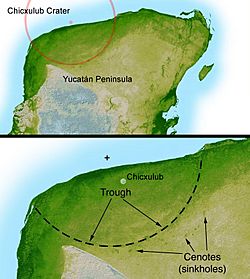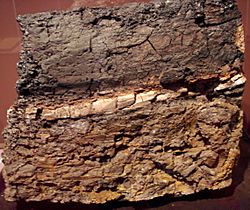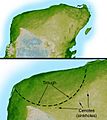K/T extinction event facts for kids

The Cretaceous–Tertiary extinction event, now called the Cretaceous–Palaeogene extinction event, was about 65.5 million years ago. It may be called the K/T extinction event or K/Pg event for short. This is the famous event which killed the dinosaurs at the end of the Cretaceous period.
It was a large-scale mass extinction of animal and plant species. The event marks the end of the Mesozoic era and the beginning of the Cainozoic era.
Contents
Effects
Dinosaur fossils are only found below the K/T boundary. This shows they became extinct before, or during the event. Mosasaurs, plesiosaurs, pterosaurs and many species of plants and invertebrates also became extinct.
Mammalian and bird groups got through the event with some extinctions. Those that survived became widespread and varied during their later evolutionary radiation.
Causes
The K/T extinctions were so sudden and far-reaching that they must have been caused by something sudden and powerful. One or more massive asteroid or meteor impacts, and increased volcanic activity have been suggested.
How quickly animals died out around the world is an important clue. Patterns in rocks also suggest causes. There are several impact craters and massive volcanic activity in the Deccan Traps in India dated to about the same time as the extinctions. Those impacts and volcanoes would have reduced sunlight and hindered photosynthesis, disrupting Earth's ecology.
The best supported theory is that the meteorite strike in the Yucatan was the main cause of the extinction at the end of the Mesozoic era.
Craters
There were several impact events across the Cretaceous/Tertiary boundary, such as the Chicxulub crater in Mexico, Boltysh crater in Ukraine, Silverpit crater in North Sea, and the Shiva crater offshore western India. The Shiva crater is a sea floor structure under the continental shelf in the Indian Ocean, west of Mumbai, India. It was named by paleontologist Sankar Chatterjee after Shiva, the Hindu god of destruction and renewal.
Related pages
Images for kids
-
Discoscaphites iris ammonite from the Owl Creek Formation (Upper Cretaceous), Owl Creek, Ripley, Mississippi
-
Kronosaurus Hunt, a rendering by Dmitry Bogdanov in 2008. Large marine reptiles, including plesiosaurians such as these, became extinct at the end of the Cretaceous.
-
Tyrannosaurus was among the dinosaurs living on Earth before the extinction.
-
The K–Pg boundary exposure in Trinidad Lake State Park, in the Raton Basin of Colorado, shows an abrupt change from dark- to light-colored rock.
-
Radar topography reveals the 180 km (112 mi)-wide ring of the Chicxulub crater.
-
Artistic impression of the asteroid slamming into tropical, shallow seas of the sulfur-rich Yucatán Peninsula in what is today Southeast Mexico. The aftermath of this immense asteroid collision, which occurred approximately 66 million years ago, is believed to have caused the mass extinction of dinosaurs and many other species on Earth. The impact spewed hundreds of billions of tons of sulfur into the atmosphere, producing a worldwide blackout and freezing temperatures which persisted for at least a decade.
-
An artist's rendering of Thescelosaurus shortly after the K–Pg mass extinction. It survived by burrowing, but would soon die of starvation.
See also
 In Spanish: Extinción masiva del Cretácico-Paleógeno para niños
In Spanish: Extinción masiva del Cretácico-Paleógeno para niños













